Web3 applications offer unique capability to monetize real estate carbon value—but web3 tech alone cannot solve dysfunction of the carbon marketplace.
The building sector’s decarbonization progress made to date has not been enough to achieve the target of limiting global warming to 1.5°C.1
According to the UN’s Intergovernmental Panel on Climate Change (IPCC), many of these limiting solutions already exist, but what is missing is the political ambition and financial incentives needed to make this happen at scale.2
To avert a catastrophic climate disaster, industries need to mobilize capital at the requisite scale and speed. However, as things stand, the investment in building decarbonization is unlikely to increase radically in the next few years.
One of the biggest challenges to sea change in this space is the financial barrier of decarbonization on the demand and supply side. This barrier will lead to significant investment gaps and a subsequent market failure to deliver the net zero carbon emission target.
Monetizing carbon value in commercial real estate through the voluntary carbon market has been explored by various research programs and modeling, but implementation has faced challenges. For example, a 2010 MIT Center for Real Estate research paper explored the idea of monetizing carbon value in commercial real estate via the voluntary carbon market.3 In 2020, the US commercial and residential sectors generated significant carbon emissions with 1.8 GMtCO2e.4 Approximately 5% of these emissions could qualify for tradable carbon offsets, resulting in a potential market value of $2.1 billion annually, with $45 per ton of Co2e, and the $30 billion asset value with a capital rate of 7%.
However, the idea has yet to gain traction due to regulatory and technological obstacles. Four challenges hinder the progress of tapping into the significant financial value that exists in commercial real estate decarbonization:
- Lack of a robust, consistent methodology to measure and verify carbon emission reduction.
- Lack of a highly streamlined, automated, cost-effective process to monetize carbon reduction from individual properties.
- Split incentives between stakeholders in the decarbonization value chain, especially owners, operators, and tenants.
- A failing voluntary carbon market, which otherwise allows carbon emitters to offset their emissions by purchasing carbon credits emitted by projects targeted at removing or reducing greenhouse gas from the atmosphere.
EMERGING WEB3 APPLICATIONS IN DECARBONIZATION
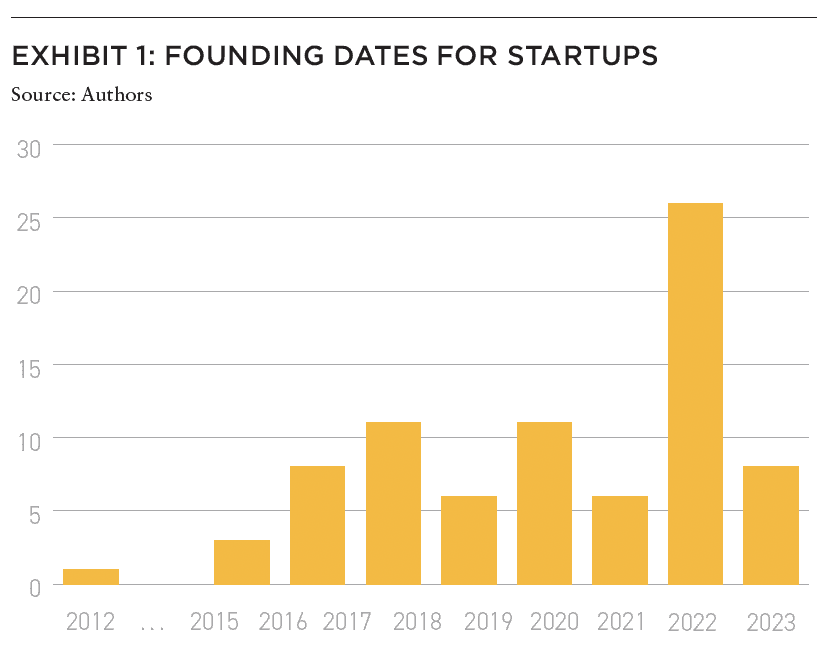
In recent years, many notable use cases have emerged in to solve climate challenges with Web3 technologies. In 2022 COP27, the Climate Change Coalition expressed interest in using blockchain to develop greenhouse gas emissions accounting.5 US President Biden’s March 2022 Executive Order 14067 calls for a discussion of the potential uses of blockchain for monitoring or mitigating climate impacts.6 The Hyperledger Climate Accounting Special Interest Group (CA2SIG), uses blockchain, AI, IoT, and Big Data to create a climate accounting system to pool, verify, and certify emissions data of corporate supply chains to create an efficient marketplace.7
Web3 refers to applications running on decentralized blockchains, facilitating transactions without intermediaries. Web3 applications are built on three key technologies: blockchain, smart contracts, and digital assets. The technology represents a paradigm shift towards decentralization in digital application business models. The blockchain serves as a decentralized database that records assets and transactions. Smart contracts automate transactions based on predefined logic. Digital assets, such as tokens and NFTs, provide a permanent record of value.
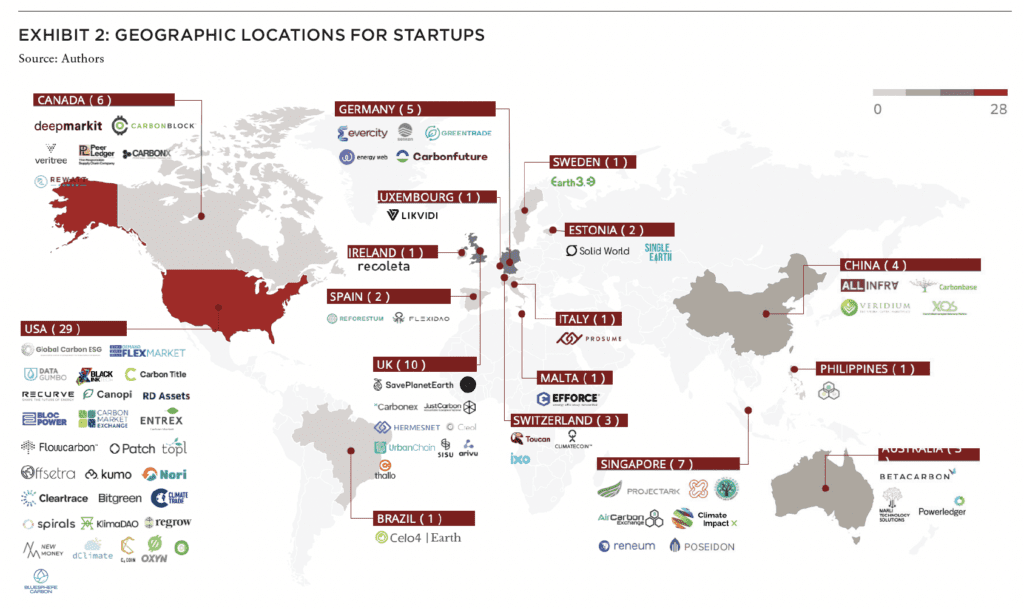
Web3 technology has gained traction with projects like Ethereum, enabling user-friendly interactions with the blockchain through decentralized applications (dApps). These dApps allow users to perform actions like generating audit reports or trading tokens directly on the blockchain.
With the rise of the voluntary carbon market, increasing carbon data disclosure mandates, and advancement in Web3 technologies, an emerging cohort of Web3 applications is helping corporations track, tokenize, and transact energy or carbon impact.
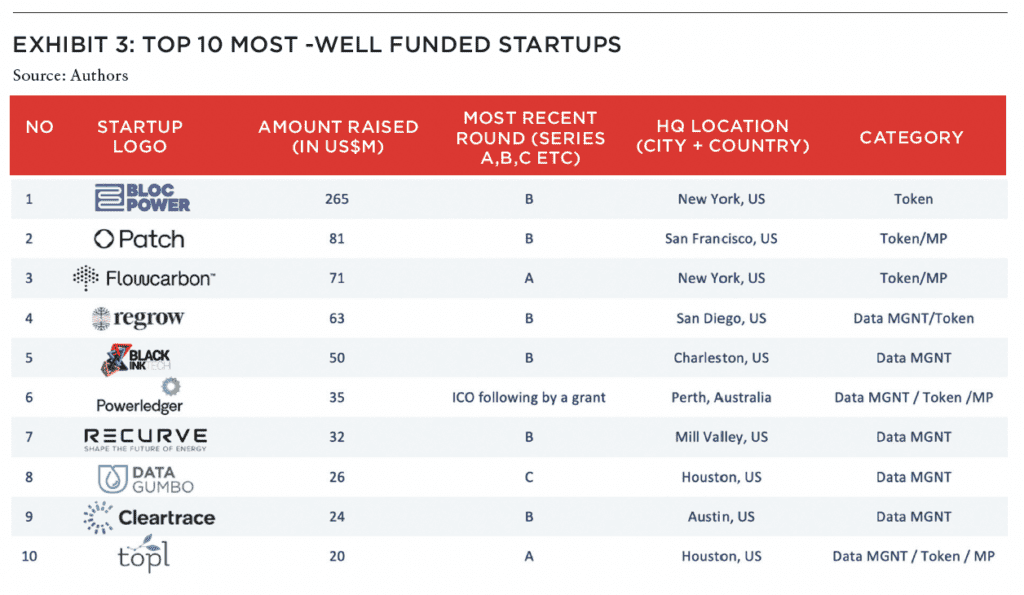
For this present analysis, we compiled a list of 79 Web3 startups that have decarbonization solutions (founded between 2012 to November 1, 2022) from Pitchbook, Crunchbase, World Economic Forum, CB Insight. We excluded all startups in the metaverse (AR/VR).
Year founded: 71% of the startups in this analysis were founded from 2018 to the present, with 2022 serving as a pivotal year for Web3, where it evolved from a nascent sector to a mainstream industry; 26 of the 79 startups were founded in 2022.
Geography: The US is home to 29 out of the 79 startups, followed by the UK (10), Singapore (7), Canada (6), and Germany(5). Nine out of the top ten most-well funded startups are also based in the US, suggesting a more mature and developed market.
Most well-funded startups: The top ten most well-funded startups have raised more than $20M of funding. Most are in Series A and B, except for Data Gumbo. Data Gumbo raised a $4M Series C in August 2022. There is no obvious evidence to indicate which category has attracted the most funding, but some of the most well-funded startups, such as Patch and FlowCarbon, are carbon offset marketplaces.
THREE CATEGORIES OF STARTUPS
This cohort of 79 startups focused on decarbonization is using Web3 technologies to do three things: data management (45 out of 79 firms); tokenization (31 out of 79 firms) and marketplace (42 out of 79 firms). But can they offer unique capabilities to tackle the four challenges in monetizing building decarbonization?
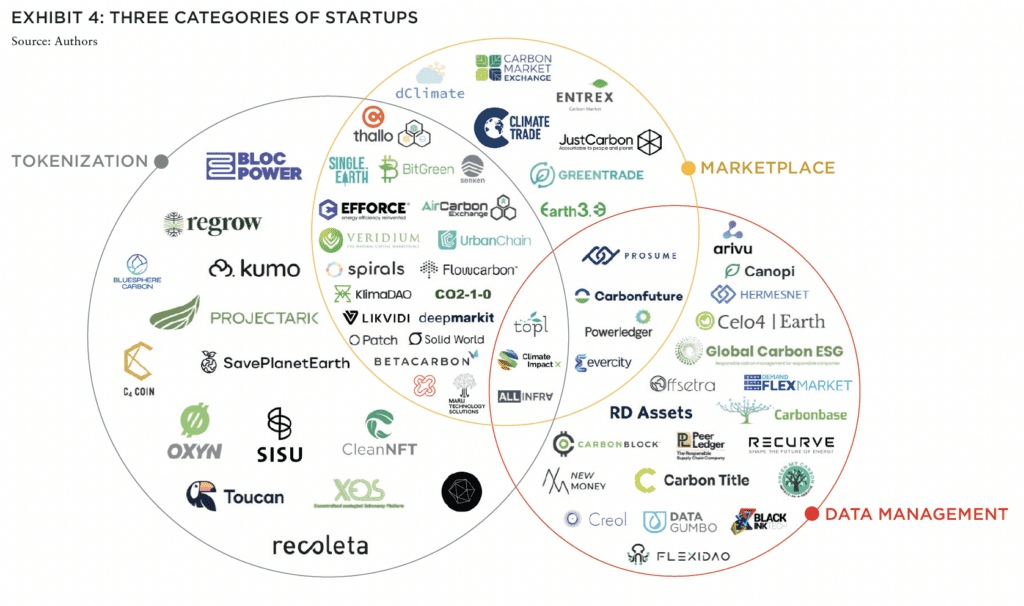
To answer this question, we examined each of their applications to unpack what problems they are solving, what are their unique capabilities and use cases. The goal was to discover if and how these applications differ from the existing approaches to accelerate decarbonization in commercial real estate.
Our findings are a mixture of “the emperor’s new clothes” and “the next big thing.” Broadly, Web3 startups are immature; most are at or before proof-of-concept. Nonetheless, Web3 technologies can play a role in providing improvements to carbon data management, aligning stakeholders’ incentives, and increasing efficiency in the energy or carbon markets.
1: Data Management
Web3 technology uses blockchain to record internet-connected device measurements, ensuring trusted and tamper-proof environmental data. Data management startups in the decarbonization space leverage Web3 tools such as IoT, AI, and ML to monitor decarbonization initiatives in real time and improve accuracy. Blockchain and smart contracts enable data transparency and immutability, benefiting asset owners, lenders, insurers, and rating agencies.
Data management startups also focus on two main use cases: carbon tracking, measurement, and audit automation. These solutions provide verifiable energy and carbon records, automate sustainability reporting, and ensure accurate measurement of carbon consumption. For example, Recurve helps utilities measure energy usage and efficiency impact, while Black Ink Tech.io and Data Gumbo automate ESG reporting.
Carbon measurement, verification, and audit automation can be addressed without using the Web3 approach. The existing approach is a centralized model. For example, Singularity, Wattcarbon, and Resurety record real-time emissions data to a centralized database. These solutions allow the customers to visualize energy data or automatically scale back their emissions on a centralized model. Applications developed in this model are proprietary, and their functionality and governance are controlled by centralized institutions, with revenues distributed to shareholders.
The difference of a Web3 approach is it utilizes open standards and decentralized protocols. The application control is no longer centralized in large platforms and aggregators but is distributed through blockchains and smart contracts. This means that trusted, centralized intermediaries may no longer be necessary for data sharing and value exchange. For example, Cleartrace and FlexiDao operate with the Web3 approach by recording energy source emissions data to a public blockchain. In its press release, Brookfield Properties announced it was partnering with Cleartrace using a decentralized ledger to digitally match One Manhattan West’s electrical consumption to generate immutable and auditable records of reduced consumption.7
The main value brought by Web3, within and beyond the decarbonization niche, is the immutability of the record and lack of intermediaries. Data management protocols using public blockchains provide permanent records through smart contracts, independent of the creators’ business status. However, Web3 approaches have limitations, such as high costs associated with storing and processing large volumes of data on public blockchains. A Web3 targeting the removal of intermediaries as an advantage must demonstrate that the added trust provides more value than the costs associated with storage and processing via the blockchain. Existing companies such as WattPower can also use open standards for automatically producing audit reports, which performs the same function as smart contracts in a Web3 approach. For these reasons, using blockchains for data management does not provide additional value until protocols improve to reduce storage and processing costs drastically.
2: Tokenization
The second category of Web3 apps for decarbonization is tokenization, which simplifies the sourcing and financing of credits by representing them as digital units on the blockchain. This brings transparency, generates pricing data, and facilitates pre-purchase agreements on a public ledger. Tokenized carbon credits can be divided into smaller units, benefiting small-scale projects and enabling easier buying, selling, and retirement of credits. For example, SolarCoin, a blockchain-based cryptocurrency, encourages the adoption of solar panels by tokenizing solar photovoltaic assets. Recognized by IRENA, SolarCoins are issued for each megawatt-hour of solar power generated and can be traded for fiat currency. With over 1.7 million MWh of solar energy incentivized across 44 countries, SolarCoin proves its effectiveness in promoting renewable energy adoption.8
Startups in the tokenization category focus on three key use cases. The first is issuing utility tokens that directly link their value to carbon emissions. These tokens store information related to certified carbon credits, auditing, and project monitoring, fostering transparency and growth in the voluntary carbon market. Companies such as Topl, AllInfra, and Single.Earth’s MERIT enables investors and stakeholders to trace the origin of GHG data associated with these tokens, providing access to data and economic rights.
The second use case for tokenization involves regenerative finance (ReFi) and decentralized finance (DeFi). ReFi on the blockchain estimates the value of natural assets based on their regeneration and preservation properties, challenging traditional finance models. Startups such as KlimaDAO and Toucan utilize utility tokens to monitor, automate reporting, and create additional financial benefits, fostering peer-to-peer transactions.
IN THIS ISSUE

NOTE FROM THE EDITOR: WELCOME TO #13
Benjamin van Loon | AFIRE
OFFICE TROUBLES: FINANCIAL RISKS AND INVESTING OPPORTUNITIES IN US CRE
Dr Alexis Crow | PwC + Byron Carlock
THE UNDERPERFORMANCE PARADOX: WHY INDIVIDUAL INVESTORS FALL BEHIND DESPITE BUYING LOW
Ron Bekkerman | Cherre + Donal Ward | Tenney 101
CLIMATE THREAT: EXTREME WEATHER IS THE NEW NORMAL FOR REAL ESTATE
Jacques Gordon, PhD | MIT
CLIMATE OPPORTUNITY AWAITS: HOW REAL ESTATE CAN INVEST IN CLIMATE ADAPTATION
Michael Ferrari, PhD and Parag Khanna, PhD | Climate Alpha
PREMIUM PRICE TAGS: INSURABILITY THROUGH PROPERTY RESILIENCE DATA
Bob Geiger | Partner Engineering & Science
REAL ESTATE WEB3: THE EMPEROR’S NEW CLOTHES OR THE NEXT BIG THING?
Zhengzheng Tan, Alice Guo, and Naveem Arunachalam | MIT
ADAPTIVE TO REUSE: COULD BUILDING CONVERSIONS BE DIFFICULT, EXPENSIVE . . . AND STILL PROFITABLE?
Josh Benaim | Aria
RENOVATE, REBRAND, REPOSITION: ADDING VALUE TO MULTIFAMILY THROUGH REVITALIZATION
Robert Kilroy, CFA | The Dermot Company + Will McIntosh, PhD | Affinius Capital
REDEFINING THE PROGRAM: A CONVERSATION WITH ARCHITECT DAVID THEODORE
Peter Grey-Wolf | Wealthcap + David Theodore | McGill University
SENIOR HOUSING UPDATE: EMERGING OPPORTUNITIES THROUGH DEMOGRAPHIC TAILWINDS AND DIMINISHING SUPPLY OUTLOOK
Robb Chapin, Jack Robinson, Andrew Ahmadi, and Morgan Zollinger | Bridge Investment Group
SENIOR HOUSING UPDATE: UNPRECEDENTED DEMOGRAPHIC ACCELERATION MAY DRIVE STRONG OPERATING FUNDAMENTALS AMID ECONOMIC SLOWDOWN
Tom Errath | Harrison Street
HOLIDAY FROM HISTORY: REASONS FOR US OPTIMISM IN A CHANGING GLOBAL ENVIRONMENT
Charlie Smith | Newmark
CRADLE TO CRADLE: AN ALLOCATOR’S VIEW ON IMPLEMENTING ESG INITIATIVES
Christopher Muoio and Katie Cappola | Madison International Realty
FREE LUNCH: MULTI-DIMENSIONAL DIVERSIFICATION IS A FULL-COURSE FREE MEAL
Elchanan Rosenheim and Tali Hadari | Profimex
CAMPAIGN MESSAGING: CFIUS, AFIDA, AND EXPANDING FEDERAL AND STATE RESTRICTIONS ON FOREIGN INVESTMENT IN US REAL ESTATE
Caren Street, John Thoms, and Anya Ram | Squire Patton Boggs

The third use case revolves around non-fungible tokens (NFTs) that certify climate impact. Platforms such as IMPT offer tokenized carbon credits as NFTs, representing specific CO2 emissions to be removed from the atmosphere. IMPT incentivizes retailers to contribute a portion of their sales margin to environmental projects, and members can track their carbon score and earn points through burning NFTs and collecting IMPT tokens.
BlocPower, a real estate sector initiative, aims to tokenize building decarbonization through a protocol for environmental justice carbon offset tokens. These tokens represent energy savings and offset greenhouse gas emissions from BlocPower’s retrofit projects. However, the tokenization initiative is still in the conceptual stage due to several challenges. Firstly, the application’s ability to establish token pricing is hindered by the inefficient and lengthy process (i.e., an average of eighteen months) to approve methodologies with carbon credit verification services such as Verra and Gold Standard. Additionally, the lack of digital infrastructure in buildings poses a challenge in automating and aggregating carbon data, limiting the ability of smaller landlords to leverage the monetary value of carbon reduction. These obstacles impacted the launch of BlocPower’s tokenization initiative, highlighting the need for a more efficient carbon credit market and better digital infrastructure.
Tokenization can potentially address broader decarbonization challenges, such as split incentives and misaligned financial incentives among stakeholders. By aggregating carbon value, tokenization facilitates trading accessibility and incentivizes pro-environmental behavior. NFTs can be used to publicly certify conservation efforts in buildings, which encourages energy optimization. For example, a tenant taking steps to reduce electricity usage could be issued with an NFT reward that publicly recognizes the amount of energy saved. For example, a tenant taking steps to reduce electricity usage could be issued with an NFT reward that publicly recognizes the amount of energy saved. While BlocPower and other similar tokenization initiatives are generally still in the conceptual stage, they have the potential to overcome hurdles related to token pricing and the lack of digital infrastructure in certain sectors.
3: Marketplace
The third category of Web3 applications for decarbonization is the marketplace, which focuses on improving the transparency and efficiency of carbon and renewable energy trading. Startups such as Flowcarbon, Bluesphere Carbon, Carbonfuture, Patch, and UrbanChain offer Web3-enabled trading infrastructure, bringing voluntary carbon credits and renewable energy credits onto the blockchain. These marketplaces streamline the process of evaluating and purchasing carbon credits from projects that impact the climate, biodiversity, and local communities.
Carbon Trade Exchange (CTX), Xpansiv CBL, AirCarbon Exchange (ACX), EKO Marketplace, and Thallo are blockchain-based exchanges that provide secondary markets for tokenized carbon credits, adding liquidity and data transparency to carbon credit trading. There are also peer-to-peer renewable energy trading platforms such as Urbanchain, enabling decentralized energy sharing using blockchain technology; FLEXMarket, a demand flexibility platform that compensates aggregators for delivering value to the grid; and the Reneum Institute in Singapore, which operates a vertically-integrated renewable energy marketplace, issuing renewable energy credits (RECs) called RENW to certified clean energy producers, allowing them to monetize their energy production and accelerate renewable energy deployment.
Blockchain platforms in the carbon market offer liquidity, transparency, security, and automation through smart contracts, addressing issues such as double-counting and fraud. However, while blockchain improves the efficiency of trading, it may not solve the fundamental challenges of the voluntary carbon market, which requires more regulation and buyer trust.
In other words, Blockchain cannot solve the root cause of voluntary carbon market failure. Verifiable data linked to carbon tokens is crucial to establish a risk profile and encourage investment in high-quality carbon credits. Each carbon project has unique characteristics and benefits, and platforms with verifiable data help investors identify, source, and track high-quality carbon projects. Regulatory measures and verifiable data are necessary to address the underlying challenges of the carbon market.
TRACKING, TOKENIZING, AND TRANSACTING
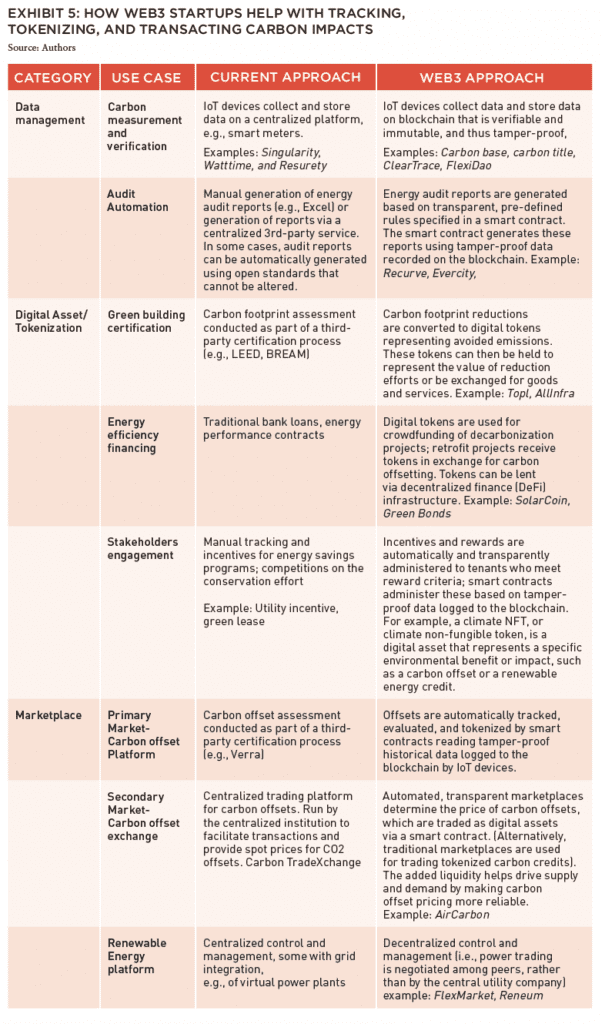
Given Web3’s decentralized and immutable nature, it can play a critical tool in helping address climate change. In the existing startup landscape, Web3 applications offer a unique capability to monetize real estate carbon value through increased data transparency and aligning stakeholders via tokenization to unlock new sources of investment.
But the Web3 technology alone cannot solve the dysfunctions of the carbon marketplace, because a. functioning voluntary carbon market needs centralized and coordinated regulations, which is a must-have to govern the carbon accounting and corporate claim standards.
The Web3 market needs policies and standards for monitoring carbon offset projects.
And besides carbon market regulation, Web3 also needs to meet certain technological and industry prerequisites to achieve its disruptive potential.
These prerequisites include automated data collection systems involving IoT devices (e.g., for carbon credit verification), and all data sources contributing to a final report must be verifiably embedded in the Web3 ecosystem. Any gaps in this ecosystem break the chain of trust and introduce an opportunity for tampering or introducing illicit data.
The distributed ledger must become faster and memory-efficient to process and store the large volume of data that needs to be recorded for climate impact monitoring. The industry also needs a straight-through process for issuing, trading, and valuing carbon and decarbonization actions via a blockchain platform.
The main goal of this process is to enable the digital monitoring and measurement, reporting, and verification tools that allow for the creation, allocating, and trading of carbon products by directly connecting the performance of an ESG action and/or asset to an industry-recognized mechanism and financial products.
—
ABOUT THE AUTHORS
Zhengzhen Tan is a Research Scientist and Lecturer at the MIT Center for Real Estate. Alice Guo has a decade of international work experience spanning real estate finance, venture capital, and corporate innovation across North America and Asia. Dr. Naveen Arunachalam received his PhD in machine learning and quantum chemistry from MIT in April 2023. He is an independent consultant performing due diligence and technology assessment for early-stage VC firms in the areas of Web3 and machine learning.
—
NOTES
1. 2020 Global Status Report For Buildings and Construction, UN Environment Programme
2. Climate Change 2022: Mitigation of Climate Change, https://www.ipcc.ch/report/ar6/wg3/
3. Binkley, A., & Brian Ciochetti. (2010). “Carbon Markets: A Hidden Value Source for Commercial Real Estate?” Journal of Sustainable Real Estate 2 (1): 67–90.
4. Data from US Environmental Protection Agency (EPA)
5. https://cointelegraph.com/news/climate-change-coalition-releases-report-on-blockchain-and-emerging-technologies-at-the-cop-27
6. OSTP (2022). Climate and Energy Implications of Crypto-Assets in the United States. White House Office of Science and Technology Policy. Washington, DC, September 8, 2022. (page 27)
7. https://www.hyperledger.org/blog/2022/10/05/climate-action-and-accounting-special-interest-group-ca2sig-wins-the-hyperledger-challenge-2022
8. https://cleartrace.io/press-releases/brookfield-properties-one-manhattan-west-to-be-powered-by-100-percent-renewable-energy/
9. Positive Blockchain.io https://positiveblockchain.io/database/solarcoin/#:~:text=SolarCoins%20can%20be%20used%20as,the%20appreciation%20of%20the%20coins
—
THIS ISSUE OF SUMMIT JOURNAL IS PROUDLY UNDERWRITTEN BY

For more than 20 years, Yardi has developed real estate investment management software that helps managers of global assets valued at trillions of dollars make informed investment decisions. Yardi Investment Suite clients include many of the world’s premier investment management funds, start-ups and partnerships of all types and sizes.
Real estate investments grow on Yardi. That’s because the Yardi Investment Suite automates complex investment management processes and provides full transparency, from the investor to the asset. Through interactive dashboards, investors can view documents and have access to reports and metrics. Collaboration is easy when your advisor or accountant is given access to view your accounts, reducing the need for emailing sensitive information.
The Yardi Investment Suite leads the real estate industry through innovation and value with fully integrated investment management, property management and accounting functionality. Fund managers and their customers can manage assets with superior efficiency and ease. Learn more.

